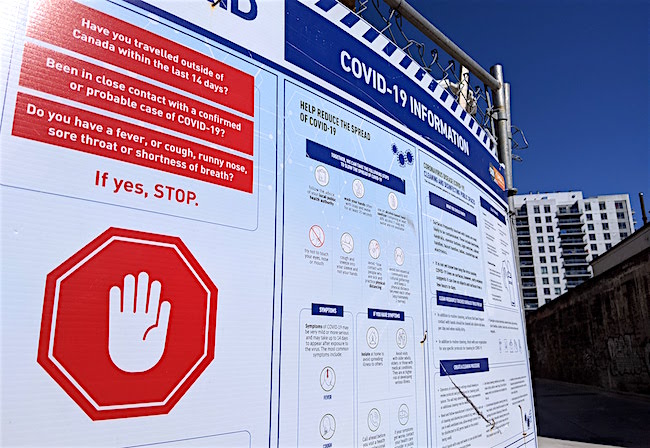
Responding to COVID-19: Legal challenges for construction employers
By John Hyde
Health & Safety Law
The pandemic prompted considerable changes on the job site last year. Though employers have largely adjusted to a new way of working on-site, legal challenges continue to rankle
It has been a rough couple of years. COVID-19 has changed the way we do things; it has changed the way we live, the way we interact with others, the way we work. With new laws enacted on a monthly — sometimes weekly — basis, the dynamic of that change, adjustment and reaction has become a challenge for every company.
Largely deemed an essential service, the construction industry is one that sits at the forefront of adaptation as it reacts to the practical implications of working during a pandemic. It is not just about building, but about managing people, providing safe workplaces (which by their nature are often difficult to supervise) and adapting to an ever-changing business reality. Workplace health and safety has changed. The way we manage, supervise and react to issues in the workplace may have been forever altered. And the challenge is real. Most of us have no real-life experience navigating around the workplace issues caused by COVID-19. Outside a hazardous materials environment, who would have ever thought that a mask would become as important as a hard hat, steel toe boots or fall arresting equipment on the job site?
In Canadian jurisdictions where the idea of a “post-COVID-19” reality is coming into play, companies are being forced to react to unique workplace problems and challenges in lockstep with legislative changes — often ahead of announcements. Laws are created to respond to problems that presently exist. Yet companies usually do not have the luxury to wait for changes to the law, before protecting the health and safety of workers. Existing employment contracts, and the majority of collective agreements, no longer provide a good foundation for an answer to the practical issues arising on worksites. Companies are forced by circumstance, to be proactive.
In Ontario, like other provinces and territories, the Occupational Health & Safety Act mandates that employers have prescribed duties to keep the workplace safe. That includes safe workplace areas, machinery and equipment, organizing ways of working safely, providing information, instruction, training and supervision. It includes hazards and actions taken to control workplace risks, and the use of personal protective equipment. Employers must provide competent supervision to ensure employees are not exposed to hazards, including regular checks to ensure health and safety instructions are being followed. Supervisors have the same responsibilities with respect to maintaining health and safety. The penalties for not doing so, are wide-ranging and include personal liability.
Understandably, the requirement to provide a safe workplace extends to COVID-19 protocols. In fact, the refusal to follow such workplace protocols can result in termination of employment for just cause. The recent grievance decision in LIUNA 183 v. Aecon Industrial (Aecon Construction Group) is a prime example. In that case, the employee grievor was told not to attend work on account of COVID 19-symptoms. He showed up anyways, claiming that staying home would be a greater risk to his job than coming to work, possibly with COVID-19. The arbitrator noted in part:
“The Grievor’s deliberate and cavalier attitude toward the COVID safety risks he represented both to his coworkers and in turn to the Company’s obligations to protect the workplace was unconscionable, unreasonable and totally unacceptable.”
Taking this into consideration, the arbitrator upheld the just cause termination.
The key to enforcement of COVID-19 protocols on the worksite is much the same as for the enforcement of all safety related protocols. Policies must be clear and followed to the letter, with consistent and fair application. Employers must be careful to ensure that where a worker raises issues concerning COVID-19, or COVID-19 policies, any subsequent disciplinary action or adverse consequence to the worker does not arise in any way from those health and safety concerns. Workers and unions will be quick to challenge any situation where a connection can be drawn between employee sponsored health and safety issues and a negative employer response. This is particularly true in the case of disciplinary measures, which may fall closely on the heels of the employee making a COVID-19 related health and safety complaint. Frequently, it results in construction grievances/complaints alleging employer reprisal under s.50 of the Occupational Health and Safety Act; one such complaint is currently winding its way through the Ontario Labour Relations Board. The key takeaway is, that discipline of any kind under COVID-19 safety protocols must be carefully considered before applying. This is important for unionized and non-unionized construction companies.
Unions must also follow COVID-19 safety protocols when their representatives are on a worksite. The failure to meet this obligation may allow a company to ask the offending person to leave the site.
Companies are well advised however to get the advice of an experienced labour lawyer, before addressing these matters on their worksites.

John Hyde is the managing partner at Hyde HR Law in Toronto. He advises management on all aspects of employment and labour law, including representation before administrative tribunals, collective agreement negotiation, arbitrations, wrongful dismissal defence and human rights.
He also assists clients in providing strategic legal and human resources advice on labour and employment matters arising out of complex mergers, acquisitions and the sale of businesses.




